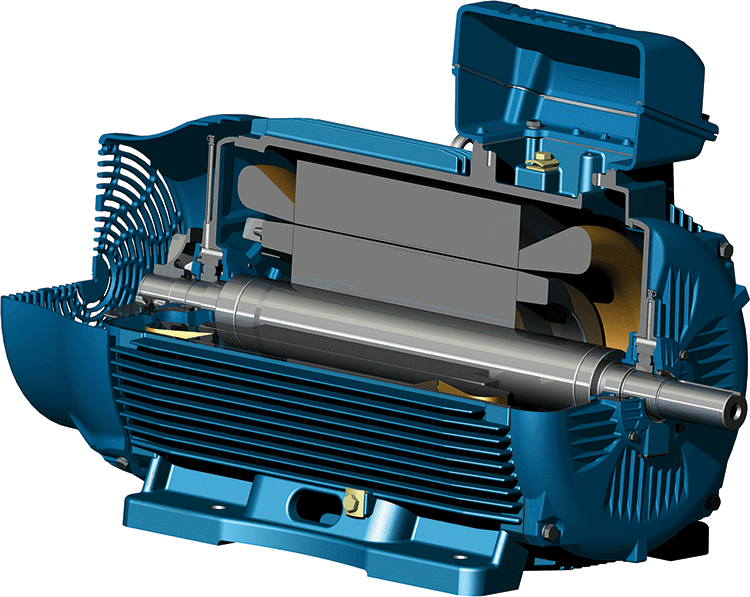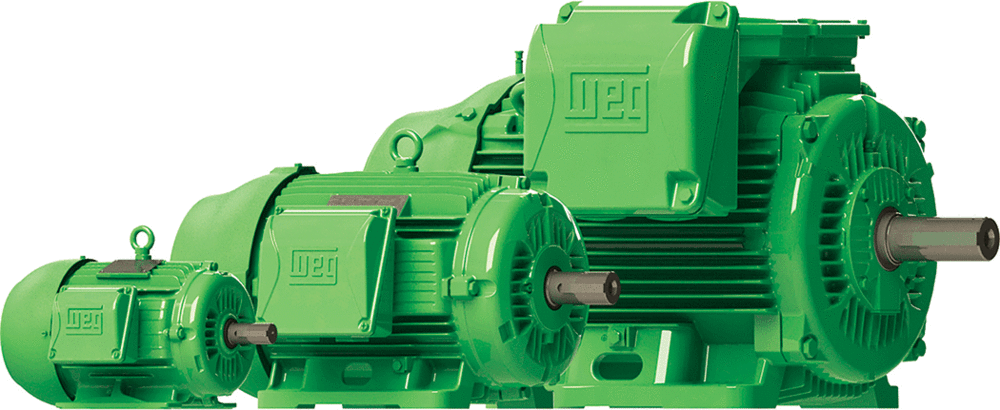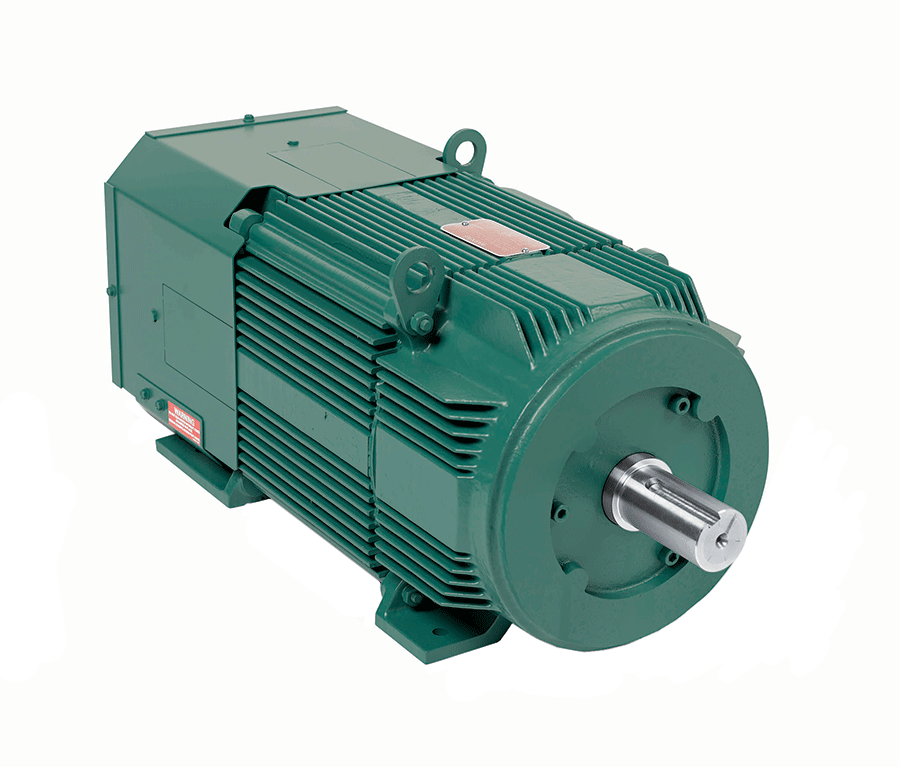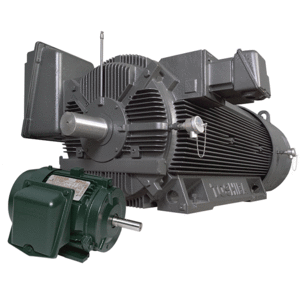Taming the Power-Hungry Beast
















PHOTO: TOSHIBA INTERNATIONAL CORP.
July 15, 2016
BY Ron Kotrba
The amount of energy consumed by electrical motors in the U.S. is staggering. The U.S. DOE reports that, in 2006, the total annual energy consumption from motor-driven equipment in the U.S. industrial, commercial, residential and transportation sectors combined was approximately 1,431 billion kilowatt-hours (kWh), or more than 38 percent of the total U.S. electrical energy use. In 2006, motor-driven systems in the industrial sector consumed roughly 632 billion kWh/year, or 44 percent of all motor-driven system energy use. This industrial sector motor use equates to about 17 percent of the total U.S. electrical energy use. Within the industrial sector, more than 62 percent of the total electrical energy use is for motor-driven equipment.
More recent data from the U.S. Energy Information Administration show nearly half of the electricity consumed in the manufacturing sector is used to power motors for fans, pumps, conveyors, compressors, and, of course, wood pellet presses, along with all the ancillary equipment that help prepare feedstock, feed the presses and package the final product for delivery.
At Indeck Ladysmith’s 90,000-ton wood pellet mill in Wisconsin, maintenance manager Kristoffer Zimmerman says the plant is stacked with motors of all sizes and styles performing a variety of functions throughout the mill. All the motors used at Indeck Ladysmith are Marathon Electric Manufacturing Corp.’s XRI brand, Zimmerman says, and the most powerful is 600 horsepower to run the microwood chipper. “The chipper draws 200 amps when nothing’s going through it,” Zimmerman says.
The microchipper makes smaller than typically sized wood chips, which are then fed into a hopper before moving to one of two hammer mills. Zimmerman says the smaller-sized chips are desirable because they put less load on the hammer mills. “Our microchipper normally needs 1,200 horsepower, but we have a unique torque converter that allows it to slip under heavy load,” he says.
The mill has two Bliss Industries Eliminator 4460 hammer mills, a wet and a dry, each powered by a 500-horsepower motor.
Three Andritz LM26-2 wood pellet presses—each equipped with a 480-volt, 3-phase, 400-horsepower motor drawing 420 amps a piece—are the extrusion workhorses of the Indeck Ladysmith mill. Zimmerman says the plant can run all three pellet presses together or individually, and for R&D purposes, Indeck Ladysmith has the ability to put different-sized dies in each of the machines with different compression ratios.
The plant also employs a few smaller, variable frequency drive motors sized at 25 horsepower or less. “The pellet presses are fed by an auger and a surge bin,” Zimmerman says. “We have a variable frequency drive motor to feed the presses, so we can change the feed rate.” A sawdust burner that heats the dryer also uses a variable frequency drive motor. The motor that blows the sawdust into the burner adjusts how much material to feed in based on the temperature of the product coming out. “After the wood comes out of the dryer, we look at that temperature,” Zimmerman says. “There’s a 15-minute response time to change the feed rate and therefore the temperature of the fire.”
All the motors in the facility are alternating current (AC), save one. The facility uses a small direct current (DC) motor in its stretch wrapping machine that palletizes 40-pound bags of wood pellets onto 1-ton pallets. Patrick Standley, business manager of paper and forest products at Baldor Electric Co., a member of the ABB group, says DC motors are common in the paper industry, often in legacy machinery. “DC requires more maintenance,” Standley says. “Most people have moved toward AC motors.”
Regulations
The Marathon XRI motors, such as those utilized at Indeck Ladysmith, are rated NEMA-premium. NEMA is the National Electrical Manufacturers Association, and its standards are adopted by the federal government to establish efficiency regulations.
For more than three decades the efficiency of new motors has been regulated by federal law. The Energy Policy and Conservation Act of 1975 required U.S. DOE to establish the most stringent standards that are both technologically feasible and economically justifiable, according to EIA, and to periodically update these standards as technology and economics evolve. Legislation has increased the federal minimum motor efficiencies requirements over the past two decades, covering motors both manufactured and imported for sale in the U.S. The Energy Policy Act of 1992 set minimum efficiency levels for all motors up to 200 horsepower purchased after October 1997. The U.S. Energy Independence and Security Act of 2007, famous in the biofuels world as the legislation in which the second and current version of the renewable fuel standard (RFS2) was passed, updated the EPAct standards starting December 2010 to what’s called NEMA-premium, including 201 to 500 horsepower motors. EISA assigns minimum, nominal, full-load efficiency ratings according to motor subtype and size.
Beginning June 1, an updated standard established by DOE in 2014 is broadening the minimum efficiency of a variety of new motors sized at 1 horsepower and up. “When regulations first moved to NEMA-premium, there were exceptions that didn’t necessarily make sense,” says Dale Basso, NEMA vice chairman and WEG Electric Corp.’s low-voltage motors product manager. “There are things in the NEMA-premium requirements today that were not in the regulations in 2010—things like footless motors. It didn’t make sense really why those were exempt. So we were building two designs, one for footless and another for footed. But when the Round 2 changes came into effect this June, they moved that and other stuff into the regulations.”
Advertisement
Round 2 regulations, also called the Integral Horsepower Rule, include motors sized as low as 1 horsepower and incorporate “almost everything except things like special shafts,” Basso says.
The new rule doesn’t mean motors that do not meet NEMA-premium standards cannot be used or sold, but rather manufacturers cannot produce new motors for sale in the U.S. after June 1 that do not meet the new efficiency standards. “Customers can still sell product if they have it on the shelves,” says Jason Carbone, a territory account manager for WEG. “They just can’t build noncompliant product for sale in the U.S. anymore.”
Below the NEMA-premium rating is what’s referred to as high-efficiency. A NEMA-premium rating is two efficiency bands above a high-efficiency rating, according to Basso. Another way to express this is to say that two efficiency bands higher than high-efficiency makes 20 percent fewer losses. The difference between each efficiency band, which is a fixed, nameplate assignment, is 10 percent loss. “You can’t do a 96 percent or 96.1 percent efficient motor,” Basso says. “But 96.2 is an efficiency band, and 95.8 is the next one down.”
DOE’s analyses estimate lifetime savings for electric motors purchased over the 30-year period that begins in the year of compliance with new and amended standards to be 7.0 quadrillion Btu. The annualized energy savings—0.23 quadrillion Btu—is equivalent to 1 percent of total U.S. industrial primary electricity consumption in 2013.
Inner Workings
Induction motors are rather basic creations that turn electrical energy into mechanical movement. Induction motors consist of a stator, which is the stationary component and made of electromagnetic iron or steel layers magnetized with copper winding and 2, 4, 6 or 8 paired poles, says Joe Hanna, marketing development manager for Toshiba International Corp. The stator features a bored center so the rotor—the rotating portion of the motor—can fit inside. The stack length of the motor is determined by how many layers of laminated, stamped steel are in the construction of the stator and rotor, Standley says. The rotor too is outfitted with electromagnets with paired poles facing toward the stator poles. As the alternating current electricity passes through the copper winding, the stator poles alternate and the rotor poles move to catch up. This happens several times a second and creates mechanical rotation energy to power almost anything needed.
Hanna says Toshiba designs its medium-voltage motors differently than the standard design. “We have a form-wound design,” he says. “It’s not just standard wire. We use multiple wires and we put them all together and wrap with a certain insulation, like a cable. The cost of our form-wound designed motors is higher than the standard induction line.”
Standley says the way manufacturers such as Baldor make motors more efficient revolves around material quality, contents and stack length. “It’s about the ability to cool,” he says. When a motor is rated at 96.2 percent efficient, it means 96.2 percent of the electricity consumed is converted to mechanical energy, while the other 3.8 percent is lost as excess heat or friction. Therefore, the ability of a motor to keep cool means less loss to heat and greater efficiency.
When motors wear out, Standley says many industrial facilities have what’s called throw-away horsepower, meaning motors less than a designated horsepower are replaced while those that are higher are rewound, or otherwise repaired. “In rewinding a motor, you can lose efficiency in the process,” he says. “And if a motor is rewound several times, it’s not going to be close to the original efficiency.” While many of these larger motors in the field have a 20-plus year lifespan, certain wear items such as bearings and seals have shorter lifespans. “If you choose to repair, you need to replace the bearings and seals,” Standley says. “And they need to be greased in day-to-day operations. Lube,” or the lack of, “is the biggest failure point,” he says.
Application, Payback
Hanna says when choosing a motor for a particular application, it’s important to look at the situation from all different angles. “One is the power line and what’s available for the motor to start,” he says. “The second is amps draw. We say, based on the application, we expect the motor to draw 200 amps. Then we look at voltage, load type, starting conditions, load inertia and how you are going to start the motor in order to select the right motor and design for that application. But it always depends on the voltage and the power line coming in.”
Load capability is a relationship of speed and torque. “Horsepower equals torque times speed divided by a constant,” Standley says.
The power factor, a function of load, is important too, Basso says. Power factor is the ratio of the actual electrical power dissipated by an AC circuit to the product of the root mean square values of current and voltage. The difference between the two essentially represents wasted power. “When it goes down, the load goes down,” Basso says. “If you have a bad power factor, it looks like a bigger number than it is, so you size the equipment to match the kilovolt amps supplied to them. So you’re not just looking at kilowatts.” He says a lousy power factor can adversely affect power bills. A good power factor, or the proper utilization of the electricity supplied through proper planning and equipment sizing, will benefit the plant and the utility. “You have a choice when buying a motor,” Basso says. “If you know you’ll only be running at 75 percent load, don’t worry about oversizing it.” What’s more important is the power factor, he says. “If you’re trying to size it close to the horsepower, then you need to look at load and size,” Basso explains. “Everyone has their own philosophy on how to operate, but if you size it right at the horsepower needed, there’s the risk of shutting down.” He says if a larger motor than the load requires is bought and installed, it costs more but, on the plus side, it will stay cooler and will have a longer life. And less load on an oversized motor shouldn’t affect the efficiency. “Motors are pretty efficient throughout a wide range,” Basso says. “If it’s 95 percent efficient at full load, then it should be 95 percent efficient at half load.”
Mike Curci, capital sales manager for biomass equipment at Andritz, a pellet press manufacturer, says when sizing equipment, the goal is to be as efficient as possible. “We look at mass balance, the materials coming and the quality specifications required for offtake, and we have a formula we put all this information into,” Curci says. “Then we make adjustments, for example, cap-ex vs. op-ex. Op-ex is important because it can save money over a long period of time. There are a number of factors. But we size it up to get the most efficient result possible.”
When Indeck Ladysmith sizes motors for various applications, Zimmerman says it’s a series of trials and errors with suggestions from the manufacturer. “When we change a motor, we usually go with same horsepower,” he says. “I have a spare for every motor here. When buying new, we might up the service factor to 1.15 or 1.25.” A 1.25 service factor means a motor rated at 10 horsepower can operate at 12.5 horsepower in short intervals as needed. He says buying NEMA-premium motors vs. older, high-efficiency models doesn’t cost that much more. “If I had a failure and didn’t have a spare, I would upgrade to a more efficient motor,” Zimmerman says. “I’m not going to get a cheap, less-efficient motor to replace it with. It’s a process of continually upgrading our facility.”
Advertisement
While buying a more efficient motor may cost a little more upfront, there is a payback in lower energy use. Carbone says the initial purchase price of the motor is only 2 percent of the total ownership costs. Standley says though it depends on energy costs and how much more efficient a new motor replacement is, payback from efficiency savings can be pretty quick. “Some are in months, and some are in years,” he says. Hanna says while a new Toshiba NEMA-premium motor may cost $30,000, even a 1 percent efficiency increase could net payback in 5 to 7 years to the user. “The average life of a motor is 25 to 30 years,” Hanna says. “Some are in the field for 40 or 50 years. It will run as long as you maintain and take care of it.”
In addition to a more efficient motor paying for itself through less energy usage, some states and utilities provide rebates or financial incentives to purchase new, higher-efficiency designs. “It varies state to state and by the local power provider,” Curci says. “Pellet plants are very big customers to power plants. And there are some benefits to being more efficient in the U.S. when it comes to offtake agreements in the EU in terms of a lower carbon footprint. Anytime a pellet plant can become more efficient and reduce its carbon footprint, it drives money toward the bottom line. It’s an important step.”
Standley says prior to government guidelines, utilities all over the country were paying customers to buy more efficient motors. “It’s the low-hanging fruit,” he says. “They don’t want to have to build more power stations.”
In Ladysmith, Wisconsin, Zimmerman says Indeck Ladysmith’s utility provides incentives to help pay for 50 percent of the project costs in moving to variable frequency drive motors.
Beyond NEMA-premium
Though NEMA-premium regulations went into full force June 1, manufacturers are providing motors that surpass these standards.
“WEG makes some models that are two more efficiency bands above NEMA-premium,” Basso says. “We call it SuperPremium.” The downside, he says, is that it’s a Design A. Different motors with the same nominal horsepower may have different start current, torque curves, speeds and other variables. NEMA classifies motor designs into A, B, C and D. With WEG’s Design A SuperPremium, Basso says the purchaser should review their starter and cable sizing before installing so it doesn’t present problems since it draws more current. “The plant may already have Design A, but they have to know,” he says. “You can’t go blindly into it or you may trip the breakers since it’s got a high starting torque.”
Also, direct-drive permanent magnet motors that eliminate the rotor and its inherent losses are advances that will help move motor technology forward into even further efficiencies, Basso adds. And unlike conventional induction motor technology, which usually requires larger sizes for increased efficiencies, direct-drive permanent magnet motors can gain efficiencies while decreasing in size.
Standley says efficiency in conventional motor technology is close to being tapped out. “At 95-plus percent efficiency, how much more can you drive out?” he asks. “New technologies in construction material or ways to remove friction forces are constantly being reviewed.”
Baldor recently announced a new hybrid motor design with performance two to four efficiency bands above NEMA-premium. “Using advanced technology, which combines the starting attributes of an induction cage with permanent magnets, the new RPM XE platform can provide substantial energy savings and performance for most centrifugal load applications,” the company states. “The motor starts like a traditional Design B induction motor and pulls into true synchronous speed and operates as a true synchronous machine. Laminated finned frame construction also contributes to power density and enhanced thermal performance by providing greater heat dissipation, which results in cooler operation and longer motor life.”
What’s next for government regulation in motor efficiency, Basso says, is improving entire systems, not just the motors themselves. DOE analysis shows that more than 70 percent of the total potential motor system energy savings is estimated to be available through system improvements by reducing system load requirements, reducing or controlling motor speed, matching component sizes to the load, upgrading component efficiency, implementing better maintenance practices and downsizing the motor when possible.
“The motor industry is not glitzy, it’s not high-tech,” Standley says. “But we’re constantly looking for ways to improve.”
Author: Ron Kotrba
Senior Editor, Pellet Mill Magazine
218-745-8347
rkotrba@bbiinternational.com
Upcoming Events





